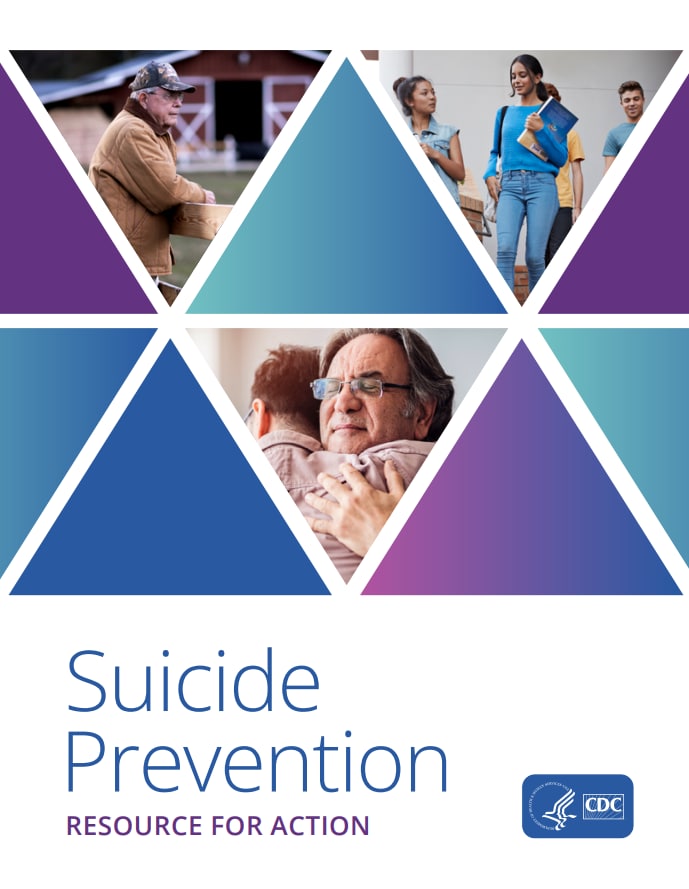At a glance
CDC’s Suicide Prevention Resource for Action (Prevention Resource) details the strategies with the best available evidence to reduce suicide. The Prevention Resource can help states and communities prioritize suicide prevention activities most likely to have an impact. The programs, practices, and policies in the Prevention Resource can be tailored to the needs of populations and communities.

Preventing suicide is a priority

Download the Prevention Resource
The Prevention Resource has three components states and communities can use to inform their suicide prevention efforts.
- Strategies are the actions to achieve the goal of preventing suicide.
- Approaches are the specific ways to advance each strategy.
- Policies, programs, and practices included have evidence of impact on suicide, suicide attempts, or risk and protective factors.
Suicide is preventable
Suicide is a serious public health problem that can have lasting harmful effects on individuals, families, and communities. It contributes to premature death, long-term disability, lost productivity, and significant healthcare costs. There are many factors that contribute to suicide. The goal of suicide prevention is to reduce factors that increase risk and increase factors that promote resilience.
Suicide deaths reflect only a portion of the problem. Every year, millions of Americans seriously think about suicide, plan, or attempt suicide. Suicide and suicide attempts can contribute to lasting impacts on individuals, families, and communities. The good news is that suicide is preventable. CDC's National Center for Injury Prevention and Control's vision of "no lives lost to suicide" relies on implementing a comprehensive public health approach to prevention. This approach:
- Uses data to drive decision-making
- Implements and evaluates multiple prevention strategies that enhance resilience and improve well-being based on the best available evidence
- Works to prevent the risk of suicide in the first place and lessen the immediate and long-term harms of suicidal behavior by helping those in times of crisis get the services and support they need
- Convenes and connects multi-sectoral partnerships through strong leadership practices
Strategies for action
The Suicide Prevention Resource for Action represents a select group of strategies based on the best available evidence to help communities and states focus on activities with the greatest potential to prevent suicide. These strategies focus on preventing the risk of suicide before it occurs and reducing the immediate and long-term harms of suicidal behavior for individuals, families, communities, and society.
See pages 100-106 of the Suicide Prevention Resource for Action for full list of approaches, policies, programs, and practices related to these strategies.
Examples:
Unemployment insurance
Social Security early retirement benefits
Supplemental Nutrition Assistance Program
Temporary Assistance for Needy Families
Housing First
Veterans Affairs Programs for Veterans Without Homes
Examples:
Counseling on Access to Lethal Means
United States Air Force Suicide Prevention Program
Gun Shop Project
Creating Suicide Safety in Schools
Examples:
National Health Service Corps
Zero Suicide
Examples:
Sources of Strength
Wingman-Connect
Men's Shed
Stack Up Overwatch Program (StOP)
Objective Zero Foundation
Examples:
Youth Aware of Mental Health Program (YAM)
Good Behavior Game
Aussie Optimism Program
Signs of Suicide (SOS)
The Incredible Years
Strengthening Families Program
Family Bereavement Program
Familias Unidas
After Deployment Adaptive Parenting Tools
Examples:
Applied Suicide Intervention Skills Training (ASIST)
Question, Persuade, and Refer (QPR)
Mental Health First Aid (MHFA)
Teen Mental Health First Aid (tMHFA)
National Suicide Prevention Lifeline
Attempted Suicide Short Intervention Program
Improving Mood—Promoting Access to Collaborative Treatment (IMPACT)
Prevention of Suicide in Primary Care Elderly: Collaborative Trial (PROSPECT)
Examples:
StandBy Support After Suicide (StandBy)
After a Suicide: A Toolkit for Schools
Safe Messaging Guidelines
National Recommendations for Depicting Suicide
Need help? Know someone who does?
Contact the 988 Suicide and Crisis Lifeline if you are experiencing mental health-related distress or are worried about a loved one who may need crisis support.
- Call or text 988
- Chat at 988lifeline.org
Connect with a trained crisis counselor. 988 is confidential, free, and available 24/7/365. Visit the 988 Suicide and Crisis Lifeline for more information at 988lifeline.org.
